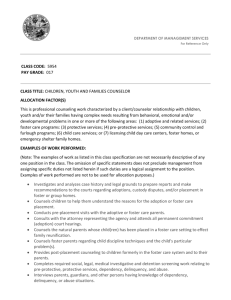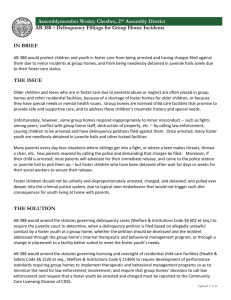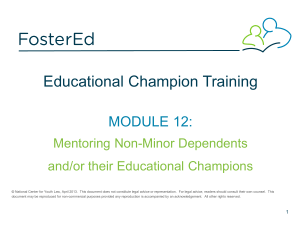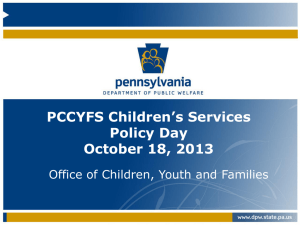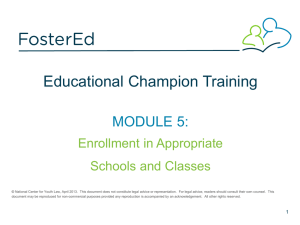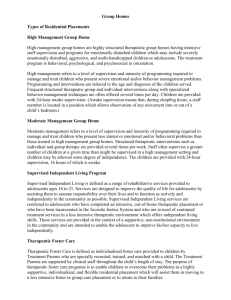Moving Youth Toward Self-Sufficiency
advertisement
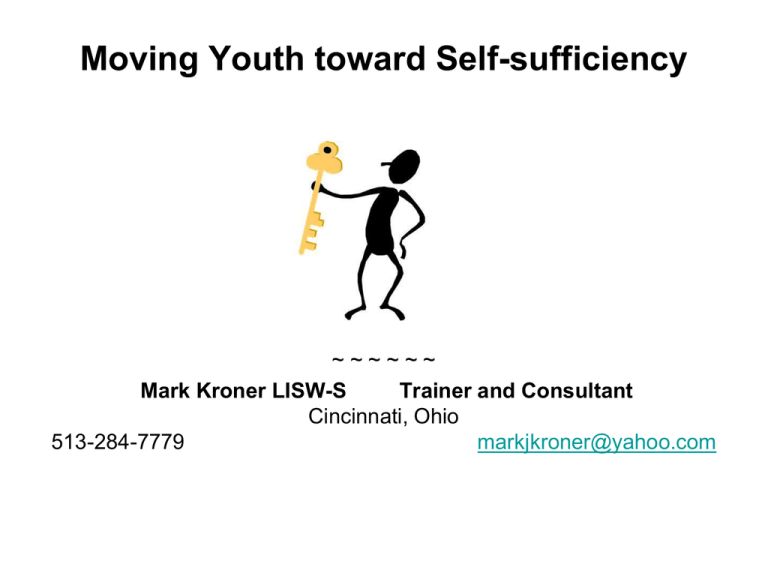
Moving Youth toward Self-sufficiency ~~~~~~ Mark Kroner LISW-S Trainer and Consultant Cincinnati, Ohio 513-284-7779 markjkroner@yahoo.com The 10 Key Elements of Effective Transition Services** 1. Education and development of entire system 2. Stable sources of funding 3. Getting entire system involved in transition process 4. Life Skills assessments and training 5. Social support development/permanency 6. Employment and Educational support 7. Real life experience 8. Most appropriate living arrangements 9. Addressing of special needs 10. Aftercare **And a well-paid case-manager to make it all work! So who still needs Independent Living? • • • • • • • • • Youth who are ready to go out on their own Youth who do not want to/cannot live with others Youth who do not want to be adopted/were adopted Youth who enter system as teens in states that end at 18 Youth with mental health issues Youth with criminal backgrounds/sex-offenses Youth who want to/do not want to return to unstable families Pregnant/parenting youth Youth who do not want to leave foster care but need to Training of System and IL staff on needs of transition age youth • • • • • • • • • • The time frame we and youth have to work within The transition realities of all youth The research on homelessness The developmental needs of T.A.Y. The current service system/lack of Who is in charge of overseeing this process The role of the case-manager/caseworker Life skills assessment/training strategies Community resources/national resources Special needs youth Living Arrangement Options • Foster homes Group homes • Individual apartments Shared housing • Supervised apartments Host homes • Roommates Shelters • Adoptive homes Relative homes • Trailers Adult/youth apartments What are the advantages and disadvantages of each option? $ources of Funding • • • • • • • • • • • Purchase of service contracts; state or country Shifting of funding from other placements HUD Donated buildings Set-asides McKinney Vento/supportive housing Family Unification Program Foundations Chafee Private donations of supplies/furnishings/cash United Way Keys to operating successful housing programs • • • • • • • • • Planned preparation of youth and adults Clear policies and expectations Consistent supervision and monitoring Plans for when things aren’t working Management of risk and liability Staff who can engage and motivate youth Connections with landlords/housing entities Tolerance of normal behavior Multiple options/back-up plans Common Concerns • • • • • • • • • • • Who signs the lease? How can you tell if a youth is ready for IL housing? What about liability? Damages? What is the best housing option? How often do you need to see a youth? How do you find landlords willing to rent to youth? Do youth have to contribute anything? Can we place foster youth in TLP/HUD programs? Shouldn’t we focus more on keeping youth with adults? What about visitors/roommates? What about after office hour crises? Life Skills assessments and training • • • • • • • • • Sharing assessment results Building life skills training from assessment results Creating workbooks Using internet for life skills materials Already developed curricula Games, videos, former clients, guest speakers Using Incentives One-on-one training/groups Weekly/monthly/weeklong/camps/retreats The Core Case-management Strategy: Talking Transition • Help youth see and prevent potential problems/options • Help youth make decisions • Give youth responsibility to take action • Keep a future focus • Expect resistance • Process “mistakes” • Develop patience Addressing Special Needs • • • • • • • • • Pregnant/parenting youth Youth with MH/CD issues Youth with developmental disabilities Youth with criminal records/sex-offenders Youth with unique cultural backgrounds LGBTQI2-S youth Youth from gangs Immigrant youth Youth with chronic medical problems Aftercare • • • • • • • Emergency assistance Non-emergency financial assistance Provisional discharge Second chances Allow for re-entry Counseling/support Involvement of former youth in training/policy development • Connections to adult services • Referrals to needed resources Useful Publications • “Housing Options for Independent Living Programs” Available at or 202-662-4278 or www.CWLA.org • “Moving In: Ten Successful IL/TL Program Models” Available at Northwest Media 800-777-6636 or www.northwestmedia.com • Housing Assistance for Youth Who Have Aged Out of Foster Care: The Role of the Chafee Foster Care Independence Program http://aspe.hhs.gov/hsp/12/chafeefostercare/rpt.shtml • Housing for Youth Aging Out of Foster Care: A Review of the Literature and Program Typology http://www.huduser.org/portal/publications/interim/hsg_fter_care.html • “A Future Near Me: Questions to guide a young adult’s journey to self-sufficiency” National Resource Center for Youth Services 918-660-3700 www.nrcys.ou.edu • “A Path Near Me: Questions to guide a young Native American journey to the future” National Resource Center for Youth Services 918-660-3700 www.nrcys.ou.edu • “Operation Independence: Individual and group life skills training activities” National Resource Center 918-660-3700 www.nrcys.ou.edu Bio: Mark J. Kroner LISW-S • Mark is an independently licensed social worker who has worked with thousands of youth in transition in the child welfare, juvenile justice, mental health and homeless youth systems. Mark has written numerous articles and books on housing and self-sufficiency and has been active as a 21 year IL program director, advocate, trainer and national consultant. • Mark has four children, ages 23,25,27 and 30 and two grandchildren, all in various states of transition.

